Download CBSE Class 12 Syllabus for Accountancy 2023 2024. Refer to the latest syllabus provided below and free download latest curriculum of Class 12 for Accountancy issued by CBSE and NCERT, free download in pdf, get topic wise weightage, suggested readings and books based on latest syllabus and guidelines. The Accountancy Class 12 Syllabus curriculum has been developed and issued by CBSE and NCERT for Accountancy in Class 12. All students studying in Class 12 are suggested to go through latest syllabus to ensure that their preparation is as per the latest syllabus issued by CBSE NCERT KVS. Class 12 Accountancy students should do preparation for Accountancy exam strictly based on the latest curriculum and concentrate more on the topics with higher weightage to help them score higher marks in Class 12 Accountancy class tests and exams
Class 12 Accountancy Syllabus
It is important for students to study as per the latest Class 12 Accountancy curriculum and marks breakup as per important topics. This will help to prepare properly for the upcoming examination. You can click on the following links to download the latest and past year syllabus provided by us below.
Year Wise Accountancy Syllabus Class 12
Course Structure
| Parts/Units | Topics | Marks |
|---|---|---|
| Part A | Accounting for Partnership Firms & Companies | 60 |
| Unit 1 | Accounting for Partnership Firms | 35 |
| Unit 2 | Accounting for Companies | 25 |
| Part B | Financial Statement Analysis | 20 |
| Unit 3 | Analysis of Financial Statements | 12 |
| Unit 4 | Cash Flow Statement | 8 |
| Part C | Project Work | 20 |
| OR | ||
| Part B | Computerized Accounting | 20 |
| Unit 3 | Computerized Accounting | |
| Part C | Project Work | 20 |
| Total | 100 | |
AD
Course Syllabus
Part A: Accounting for Partnership Firms and Companies
Unit 1: Accounting for Partnership Firms
-
Partnership − Features, Partnership Deed
-
Provisions of the Indian Partnership Act 1932 in the absence of partnership deed
-
Fixed v/s fluctuating capital accounts
-
Preparation of Profit and Loss Appropriation account- division of profit among partners, guarantee of profits
-
Past adjustments (relating to interest on capital, interest on drawing, salary and profit sharing ratio)
-
Goodwill − nature, factors affecting and methods of valuation - average profit, super profit and capitalization
Accounting for Partnership firms - Reconstitution and Dissolution
-
Change in the Profit Sharing Ratio among the existing partners − Sacrificing ratio, Gaining ratio,
-
Accounting for revaluation of assets and reassessment of liabilities and treatment of reserves and accumulated profits
-
Preparation of revaluation account and balance sheet
-
-
Admission of a partner −
-
Effect of admission of a partner on change in the profit sharing ratio
-
Treatment of goodwill (as per as 26)
-
Treatment for revaluation of assets and reassessment of liabilities
-
Treatment of reserves and accumulated profits
-
Adjustment of capital accounts and preparation of balance sheet
-
-
Retirement and death of a partner −
-
Effect of retirement / death of a partner on change in profit sharing ratio
-
Treatment of goodwill (as per as 26)
-
Treatment for revaluation of assets and reassessment of liabilities
-
Adjustment of accumulated profits and reserves
-
Adjustment of capital accounts and preparation of balance sheet
-
Preparation of loan account of the retiring partner
-
Calculation of deceased partner’s share of profit till the date of death
-
Preparation of deceased partner’s capital account
-
executor’s account and preparation of balance sheet
-
-
Dissolution of a partnership firm −
-
Types of dissolution of a firm
-
Settlement of accounts - preparation of realization account, and other related accounts
-
Capital accounts of partners and cash/bank a/c (excluding piecemeal distribution, sale to a company and insolvency of partner(s)
-
Unit-2 Accounting for Companies
Accounting for Share Capital
-
Share and share capital − Nature, Types
-
Accounting for share capital −
-
Issue and allotment of equity shares
-
Private placement of shares
-
Employee Stock Option Plan (ESOP)
-
Public subscription of shares - over subscription and under subscription of shares
-
Issue at par and at premium
-
Calls in advance and arrears (excluding interest)
-
Issue of shares for consideration other than cash
-
-
Accounting treatment of forfeiture and re-issue of shares
-
Disclosure of share capital in company’s Balance Sheet.
Accounting for Debentures
-
Debentures −
-
Issue of debentures at par, at a premium and at a discount
-
Issue of debentures for consideration other than cash
-
Issue of debentures with terms of redemption
-
Debentures as collateral security-concept, interest on debentures
-
-
Redemption of debentures −
-
Lump sum, draw of lots and purchase in the open market (excluding exinterest and cum-interest)
-
Creation of Debenture Redemption Reserve
-
Part B: Financial Statement Analysis
Unit 3: Analysis of Financial Statements
-
Financial statements of a company − Statement of Profit and Loss and Balance Sheet in the prescribed form with major headings and sub headings (as per Schedule III to the Companies Act, 2013)
-
Financial Statement Analysis − Objectives, Importance, Limitations
-
Tools for Financial Statement Analysis − Comparative statements, Common size statements, Cash flow analysis, Ratio analysis,
-
Accounting Ratios − Objectives, Classification, Computation
-
Liquidity Ratios − Current ratio, Quick ratio
-
Solvency Ratios − Debt to Equity Ratio, Total Asset to Debt Ratio, Proprietary Ratio, Interest Coverage Ratio
-
Activity Ratios − Inventory Turnover Ratio, Trade Receivables Turnover Ratio, Trade Payables Turnover Ratio and Working Capital Turnover Ratio
-
Profitability Ratios − Gross Profit Ratio, Operating Ratio, Operating Profit Ratio, Net Profit Ratio and Return on Investment
Unit 4: Cash Flow Statement
- Meaning
- Objectives
- Preparation (as per AS 3 (Revised) (Indirect Method only)
Part B: Computerised Accounting
Unit 3: Computerised Accounting
-
Overview of Computerised Accounting System −
- Introduction: Application in Accounting
- Features of Computerised Accounting System
- Structure of CAS
- Software Packages: Generic; Specific; Tailored
-
Accounting Application of Electronic Spreadsheet −
-
Concept of electronic spreadsheet
-
Features offered by electronic spreadsheet
-
Application in generating accounting information - bank reconciliation statement; asset accounting; loan
-
repayment of loan schedule, ratio analysis
-
Data representation - graphs, charts and diagrams
-
-
Using Computerized Accounting System
-
Steps in installation of CAS, codification and Hierarchy of account heads, creation of accounts
-
Data − Entry, validation and verification
-
Adjusting entries, preparation of balance sheet, profit and loss account with closing entries and opening entries
-
Need and security features of the system
-
-
Database Management System (DBMS)
-
Concept and Features of DBMS
-
DBMS in Business Application
-
Generating Accounting Information – Payroll
-
Detailed syllabus with Notes
Part A – Accounting for Partnership Firms and Companies
Unit 1: Accounting for Partnership Firms
-
Partnership: features, Partnership Deed.
- Provisions of the Indian Partnership Act 1932 in the absence of partnership deed.
- Fixed v/s fluctuating capital accounts. Preparation of Profit and Loss Appropriation account- division of profit among partners, guarantee of profits.
- Past adjustments (relating to interest on capital, interest on drawing, salary and profit sharing ratio).
- Goodwill: meaning, nature, factors affecting and methods of valuation – average profit, super profit and capitalization.
Note: Interest on partner’s loan is to be treated as a charge against profits.
Goodwill: meaning, factors affecting, need for valuation, methods for calculation (average profits, super profits and capitalization), adjusted through partners capital/ current account.
Accounting for Partnership firms – Reconstitution and Dissolution
- Change in the Profit Sharing Ratio among the existing partners – sacrificing ratio, gaining ratio, accounting for revaluation of assets and reassessment of liabilities and treatment of reserves, accumulated profits and losses. Preparation of revaluation account and balance sheet.
- Admission of a partner – effect of admission of a partner on change in the profit sharing ratio, treatment of goodwill (as per AS 26), treatment for revaluation of assets and reassessment of liabilities, treatment of reserves, accumulated profits and losses, adjustment of capital accounts and preparation of capital, current account and balance sheet.
- Retirement and death of a partner: effect of retirement / death of a partner on change in profit sharing ratio, treatment of goodwill (as per AS 26), treatment for revaluation of assets and reassessment of liabilities,
adjustment of accumulated profits, losses and reserves, adjustment of capital accounts and preparation of capital, current account and balance sheet. Preparation of loan account of the retiring partner. - Calculation of deceased partner’s share of profit till the date of death. Preparation of deceased partner’s capital account and his executor’s account.
- Dissolution of a partnership firm: meaning of dissolution of partnership and partnership firm, types of dissolution of a firm. Settlement of accounts – preparation of realization account, and other related accounts: capital accounts of partners and cash/bank a/c (excluding piecemeal distribution, sale to a company and insolvency of partner(s)).
Note:
(i) If the realized value of tangible assets is not given it should be considered as realized at book value itself.
(ii) If the realized value of intangible assets is not given it should be considered as nil (zero value).
(ii) In case, the realization expenses are borne by a partner, clear indication should be given regarding the payment thereof.
Unit-3 Accounting for Companies
Accounting for Share Capital
- Features and types of companies.
- Share and share capital: nature and types.
- Accounting for share capital: issue and allotment of equity and preferences shares. Public subscription of shares – over subscription and under subscription of shares; issue at par and at premium, calls in advance and arrears (excluding interest), issue of shares for consideration other than cash.
- Concept of Private Placement and Employee Stock Option Plan (ESOP), Sweat Equity.
- Accounting treatment of forfeiture and reissue of shares.
- Disclosure of share capital in the Balance Sheet of a company.
Accounting for Debentures
- Debentures: Meaning, types, Issue of debentures at par, at a premium and at a discount. Issue of debentures for consideration other than cash; Issue of debentures with terms of redemption; debentures as collateral security-concept, interest on debentures (concept of TDS is excluded). Writing off discount / loss on issue
of debentures.
Note: Discount or loss on issue of debentures to be written off in the year debentures are allotted from Security Premium Reserve (if it exists) and then from Statement of Profit and Loss as Financial Cost (AS 16)
Part B: Financial Statement Analysis
Unit 4: Analysis of Financial Statements
Financial Statements of a Company: Meaning, Nature, Uses and importance of financial Statement
Statement of Profit and Loss and Balance Sheet in prescribed form with major headings and sub headings (as per Schedule III to the Companies Act, 2013)
Note: Exceptional items, extraordinary items and profit (loss) from discontinued operations are excluded.
- Financial Statement Analysis: Meaning, Significance Objectives, importance and limitations.
- Tools for Financial Statement Analysis: Comparative statements, common size statements, Ratio analysis, Cash flow analysis.
- Accounting Ratios: Meaning, Objectives, Advantages, classification and computation.
- Liquidity Ratios: Current ratio and Quick ratio.
- Solvency Ratios: Debt to Equity Ratio, Total Asset to Debt Ratio, Proprietary Ratio and Interest Coverage Ratio. Debt to Capital Employed Ratio.
- Activity Ratios: Inventory Turnover Ratio, Trade Receivables Turnover Ratio, Trade Payables Turnover Ratio, Fixed Asset Turnover Ratio, Net Asset Turnover Ratio and Working Capital Turnover Ratio.
- Profitability Ratios: Gross Profit Ratio, Operating Ratio, Operating Profit Ratio, Net Profit Ratio and Return on Investment.
Note: Net Profit Ratio is to be calculated on the basis of profit before and after tax.
Unit 5: Cash Flow Statement
Meaning, objectives Benefits, Cash and CashEquivalents, Classification of Activities and preparation (as per AS 3 (Revised) (Indirect Method only)
Note:
(i) Adjustments relating to depreciation and amortization, profit or loss on sale of assets including investments, dividend (both final and interim) and tax.
(ii) Bank overdraft and cash credit to be treated as short term borrowings.
(iii) Current Investments to be taken as Marketable securities unless otherwise specified.
Note: Previous years’ Proposed Dividend to be given effect, as prescribed in AS-4, Events occurring after the
Balance Sheet date. Current years’ Proposed Dividend will be accounted for in the next year after it is declared
by the shareholders.
Project Work
One specific project based on financial statement analysis of a company covering any two aspects from the
following:
1. Comparative and common size financial statements
2. Accounting Ratios
3. Segment Reports
4. Cash Flow Statements
OR
Part B: Computerised Accounting
Unit 4: Computerised Accounting
Overview of Computerised Accounting System
- Introduction: Application in Accounting.
- Features of Computerised Accounting System.
- Structure of CAS.
- Software Packages: Generic; Specific; Tailored.
Accounting Application of Electronic Spreadsheet
- Concept of electronic spreadsheet.
- Features offered by electronic spreadsheet.
- Application in generating accounting information – bank reconciliation statement; asset accounting; loan repayment of loan schedule, ratio analysis
- Data representation- graphs, charts and diagrams.
Using Computerized Accounting System.
- Steps in installation of CAS, codification and Hierarchy of account heads, creation of accounts.
- Data: Entry, validation and verification.
- Adjusting entries, preparation of balance sheet, profit and loss account with closing entries and opening entries.
- Need and security features of the system.
Snapshot from CBSE Issued Syllabus Pdf
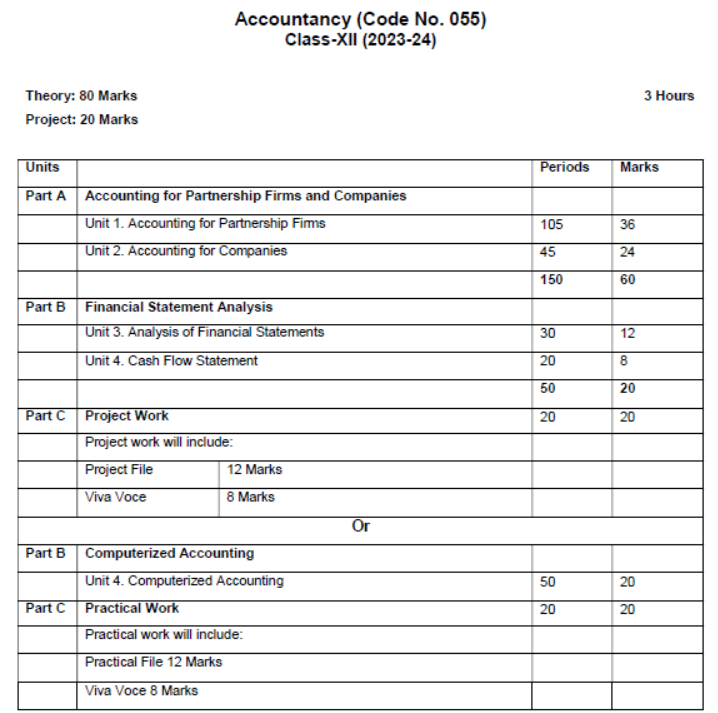
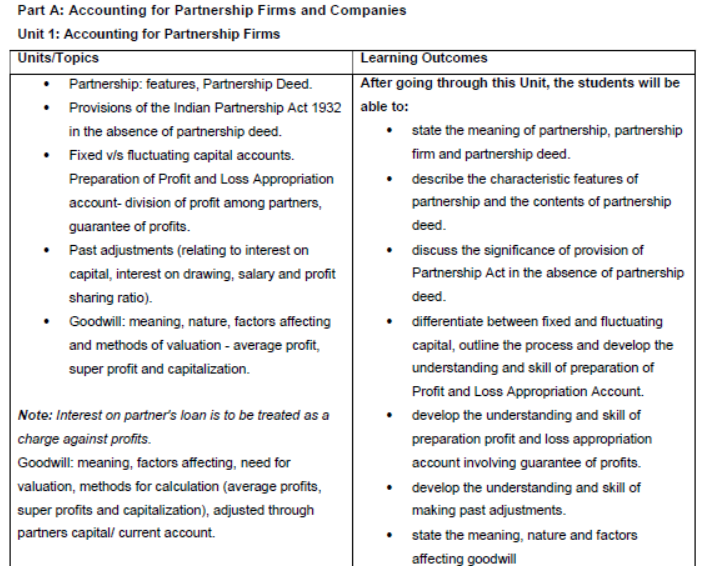
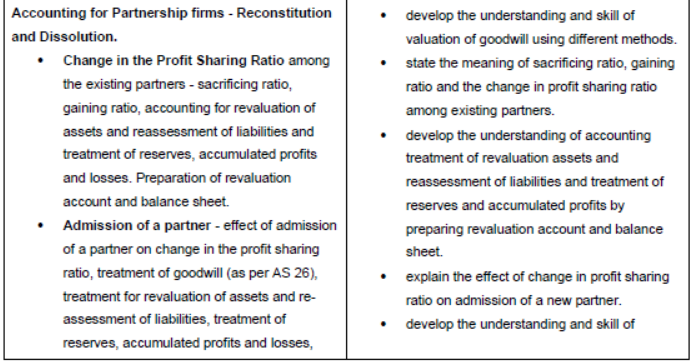
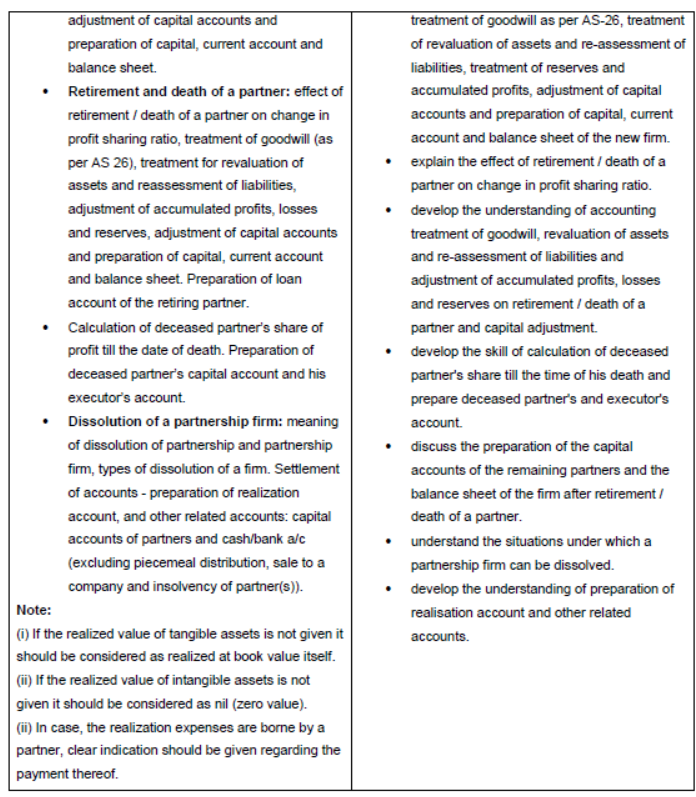

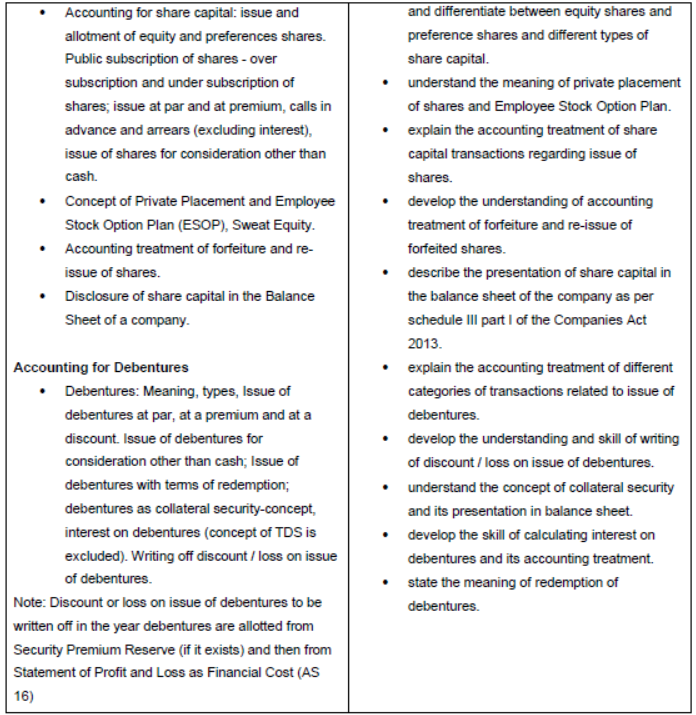

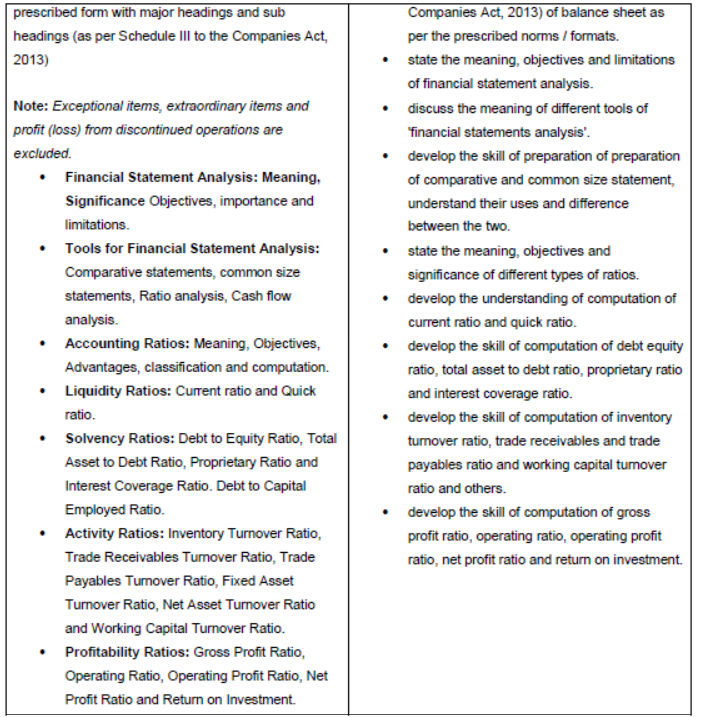

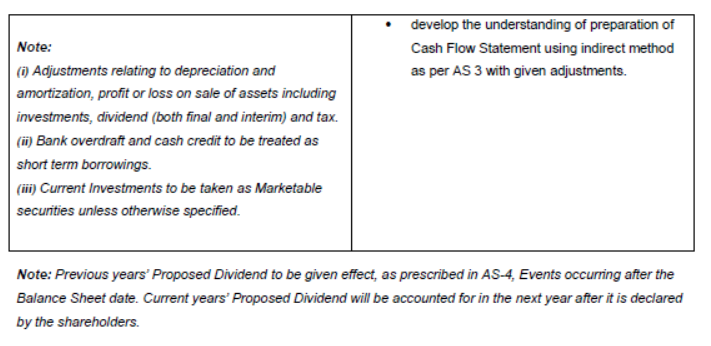
Project Work
One specific project based on financial statement analysis of a company covering any two aspects from the following:
1. Comparative and common size financial statements
2. Accounting Ratios
3. Segment Reports
4. Cash Flow Statements
OR
Part B: Computerised Accounting
Unit 4: Computerised Accounting
Overview of Computerised Accounting System
- Introduction: Application in Accounting.
- Features of Computerised Accounting System.
- Structure of CAS.
- Software Packages: Generic; Specific; Tailored.
Accounting Application of Electronic Spreadsheet.
- Concept of electronic spreadsheet.
- Features offered by electronic spreadsheet.
- Application in generating accounting information - bank reconciliation statement; asset accounting;
loan repayment of loan schedule, ratio analysis
- Data representation- graphs, charts and diagrams.
Using Computerized Accounting System.
- Steps in installation of CAS, codification and Hierarchy of account heads, creation of accounts.
- Data: Entry, validation and verification.
- Adjusting entries, preparation of balance sheet, profit and loss account with closing entries and opening entries.
- Need and security features of the system.
Part C: Practical Work
Prescribed Books:
Financial Accounting -I Class XI NCERT Publication
Accountancy -II Class XI NCERT Publication
Accountancy -I Class XII NCERT Publication
Accountancy -II Class XII NCERT Publication
Accountancy – Class XII NCERT Publication
Computerised Accounting System
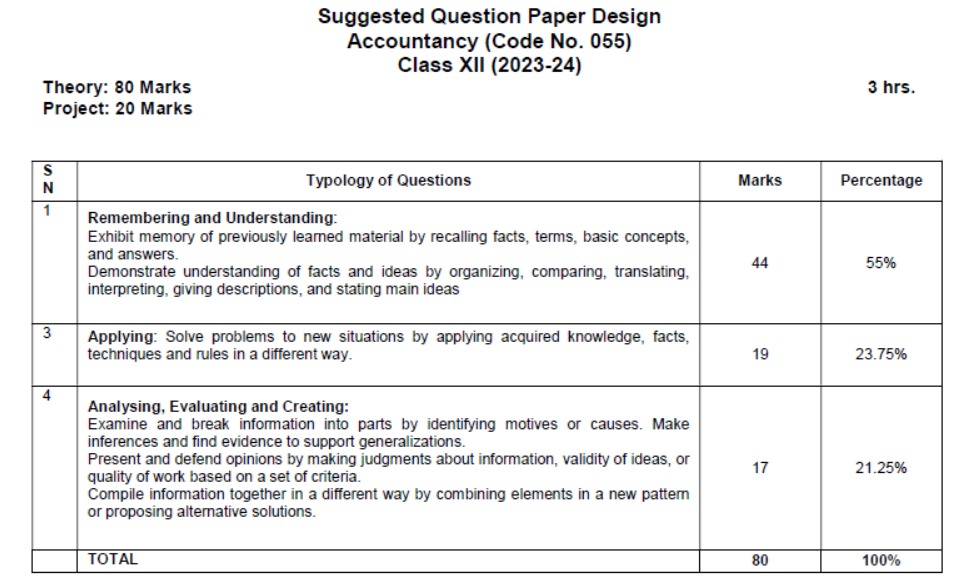
You can download the CBSE 2025 Syllabus for Class 12 Accountancy for latest session from StudiesToday.com
Yes, you can click on the links above and download Syllabus in PDF for Class 12 for Accountancy
Yes, the syllabus issued for Class 12 Accountancy have been made available here for latest 2025 academic session
You can easily access the links above and download the Class 12 Syllabus Accountancy
There is no charge for the Syllabus for Class 12 CBSE Accountancy you can download everything free
Planning your studies as per syllabus given on studiestoday for Class 12 subject Accountancy can help you to score better marks in exams
Yes, studiestoday.com provides all latest CBSE Class 12 Accountancy Syllabus with suggested books for current academic session
Yes, studiestoday provides curriculum in Pdf for Class 12 Accountancy in mobile-friendly format and can be accessed on smartphones and tablets.
Yes, syllabus for Class 12 Accountancy is available in multiple languages, including English, Hindi


